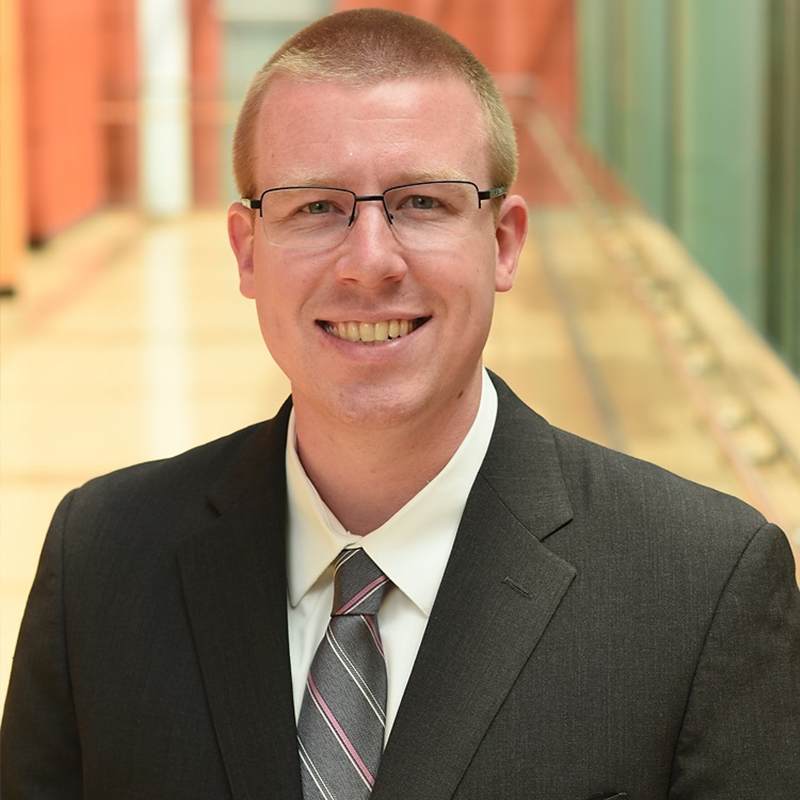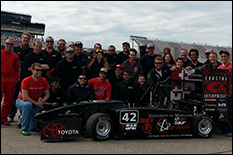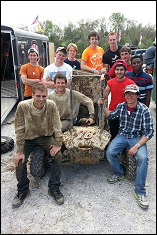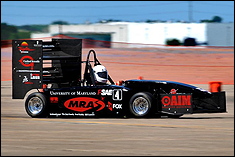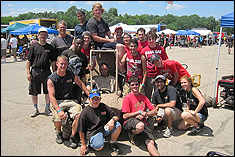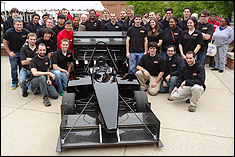News Story
Life in the Fast Lane
Mechanical Engineering alumnus Mike Cook (B.S. ’08) is no stranger to life in the fast lane. Just this past February, the former Terps Racing team leader was a member of the Daytona 500-winning No. 41 team of Stewart-Haas Racing (SHR). But a career in NASCAR wasn’t always on his horizon.

When Cook arrived at the University of Maryland (UMD) in 2001, his intention was to pursue a degree in mathematics. However, after encountering Terps Racing, the school’s Formula Society of Automotive Engineers (SAE) student competition team before his senior year, Cook opted to switch gears and transitioned from mathematics to mechanical engineering.
“Growing up, I always had an interest in cars and racing,” explained Cook. “This program really sucked me down the rabbit hole. I switched my major to mechanical engineering, and that basically restarted my college career.”
Over the next few years, Cook devoted his energy to Terps Racing, and in 2007 became the team leader. During that time, the team secured its best finish, 15th, in the Formula SAE Michigan competition. The team went on to win the 2008 Formula SAE West student competition, beating out 59 other universities.
Under the mentorship of Terps Racing faculty advisor Dr. Greg Schultz, Cook secured an internship with Dale Earnhardt Inc. for the summers of 2006 and 2007, where he would work with engineer Johnny Klausmeier, a fellow Maryland native and University of Maryland Baltimore County grad.
However, after graduation, Cook chose not to relocate to Charlotte, North Carolina, the home base of most of the NASCAR race teams. Instead, he took a job with the U.S. Army at Aberdeen Proving Grounds. There he worked with fellow UMD alumni Bill Frazer (B.S. ’79), Greg Ramsey (B.S. ’05), Kevin Kefauver (B.S. ’97, M.S. ’99) and Ivan Tong (B.S. ’99, M.S. ’03) and Dr. Schultz, where he did automotive testing with Aberdeen’s state-of-the-art equipment.
In addition to working at Aberdeen, Cook continued taking graduate courses in mechanical engineering at Maryland while serving as a mentor to Terps Racing from 2009 to 2011.
In 2014, Cook received a call from Klausmeier with an opportunity to work as a race engineer on the No. 10 car at SHR with driver Danica Patrick. The allure of being back in the garage was too much to resist, and Cook relocated to Mooresville, North Carolina, where he would become the second engineer on the team.
Moving to North Carolina wasn’t the only big change Cook would encounter with SHR. After a year with the No. 10 team, Cook transferred to the No. 41 car of Kurt Busch. In 2016, the team announced a manufacturer change from Chevrolet, whom the team had been with since its inception, to Ford Motor Company. It was a change almost unheard-of in the sport, according to Cook.
While the change offered great opportunities for performance improvement, it also meant that the engineering team needed to redesign and rebuild their racecars from the outside in. That required not only changing the bodies on the racecars, but also the chassis, suspension and all peripheral systems to accommodate the new Ford engines.
“And that was the easy part,” Cook said. “On the engineering side of things, every piece of software we used changed. The two most notable things that we live and die by are our simulations programs and our database. The database is a cornerstone for our organization. Every part on every car is tracked. Every run we make in practice is tracked, from lap times to driver comments, setups and weather. That information is then shared in real-time among our four-car team, which allows us to quickly see what our teammates are doing and if they are going faster or slower with those changes during practice sessions and the race. When you have a four-car team, competing at 38 races a year, our run logs are easily in the thousands for one year. Our future success often hinges on our ability to understand what has already been done, and if it works or not. Practice time is very limited so you need to keep very good notes of what you have already done.”
On top of the engineering challenges, the team also had to work with a brand-new, custom database system as well as a new simulation package, all of which were developed by Ford from the ground up. While the rollout was successful and has helped propel SHR to victory lane in its first race with Ford, the learning curve was steep.
“When we’re at the race track, the pace moves very quickly and having to navigate this new software is a challenge,” Cook said, “…at least until it becomes muscle memory. As the second engineer, our number-one priority is making sure that everything is documented and the database is up-to-date. I document every setup change, part change, driver comment, lap time and so on. In addition to that, I also have a much larger role in car setup from tire analysis, race strategy, fuel mileage and overall data breakdown.”
Fast-forward to Daytona, and the culmination of hard work and team efforts paid off.
“The Daytona 500, and speedway racing in general, is much more about all of the preparation at the shop than the actual car setup at the track,” Cook explained. “Engineers have a different role at speedway races than all other tracks. Success at speedway tracks comes down to horsepower, aerodynamic drag, luck and car setup in that order. To win the 500 is really a testament to the whole shop working together.”
However, this particular Daytona win did come down to engineering ingenuity. While the team’s speedway cars can typically average 47 laps on a tank of gas, and most cars pitted on lap 150 of the 200-lap race, Busch’s team opted to stretch its fuel mileage and make its pit stop on lap 151. According to Cook, the team could have been disadvantaged because Kurt Busch, driver of the No. 41 Ford, would have to restart behind the cars that pitted on the previous lap. But he did have the advantage of having an additional fuel in the tank.
The strategy paid off for the team as several of the lead cars ran out of fuel in the closing laps. Busch was able to maneuver into the lead while the other drivers were unable to organize quickly enough to try to catch up. Busch ultimately won the Daytona 500 having led just one lap – the final one – the fewest ever led by a Daytona 500 winner.
“It was amazing,” Cook said when asked what it was like to be part of the winning team. “There were 100,000 people cheering, but when I got out there on the grass to celebrate with everyone, all of that went quiet. Kurt left the car running. It still had enough fuel to do a burnout and make it to victory lane, where it finally ran out. All I could hear was the idling of the car. It was surreal. On one hand, you’re being broadcast across the world for millions to watch, and on the other, it seemed just like a bunch of car guys hanging out in our garage.”
While the Daytona race was a huge achievement for the team, the race was just the start of the 2017 NASCAR season. For Cook, the rest of the season will keep him in the fast lane as the team travels from race to race. Most weeks, he travels Thursday to Sunday and sometimes beyond if there are scheduled test sessions. While he loves his job, he credits the support of his wife, Meredith DeMoss Cook (M.S. ’08), for enabling him to stay the course.
“We all sacrifice a lot to do this. My loving wife is really the foundation of our family, which lets me do this,” Cook added. “There is still a long season ahead of us. There will be many ups and downs throughout, and our ultimate goal is to win the championship. However, I will never forget my biggest win, the 2017 Daytona 500.”
Published May 24, 2017
